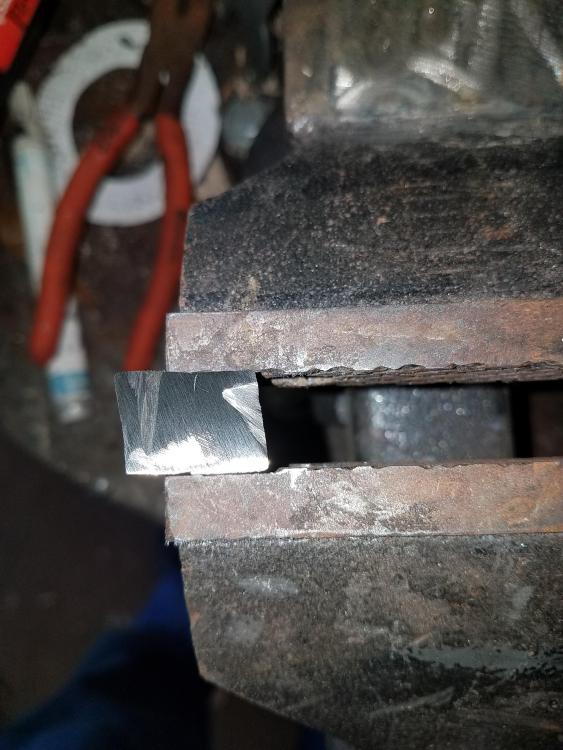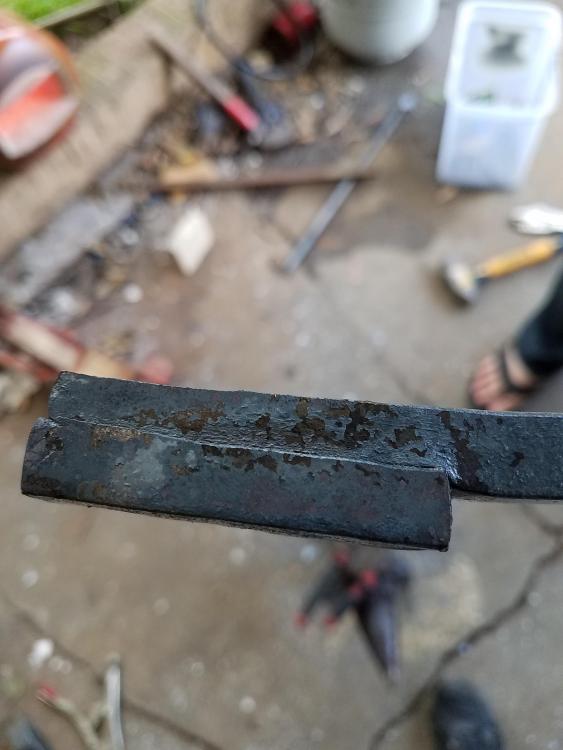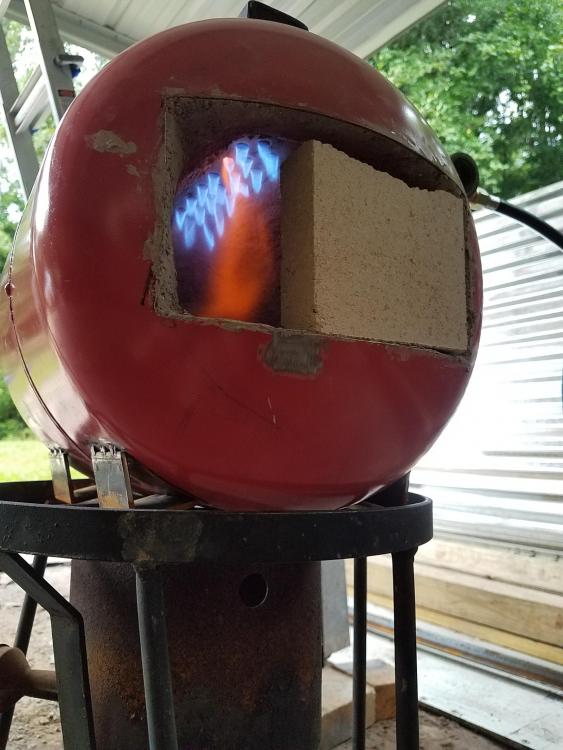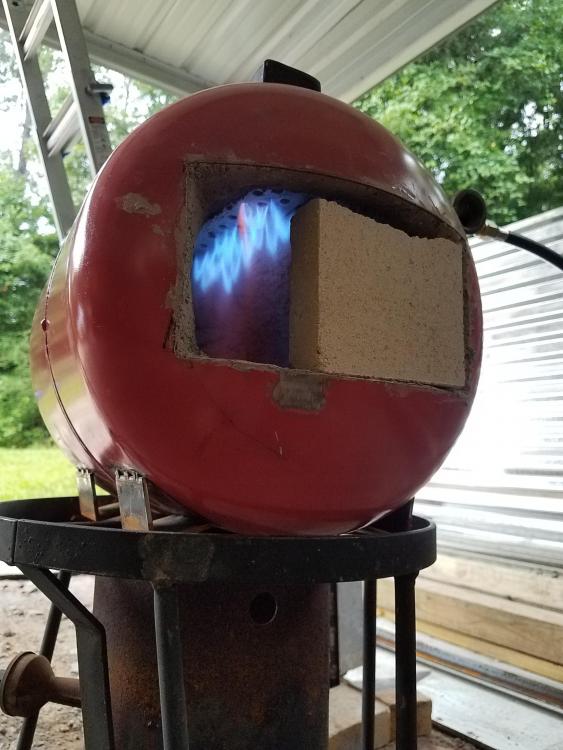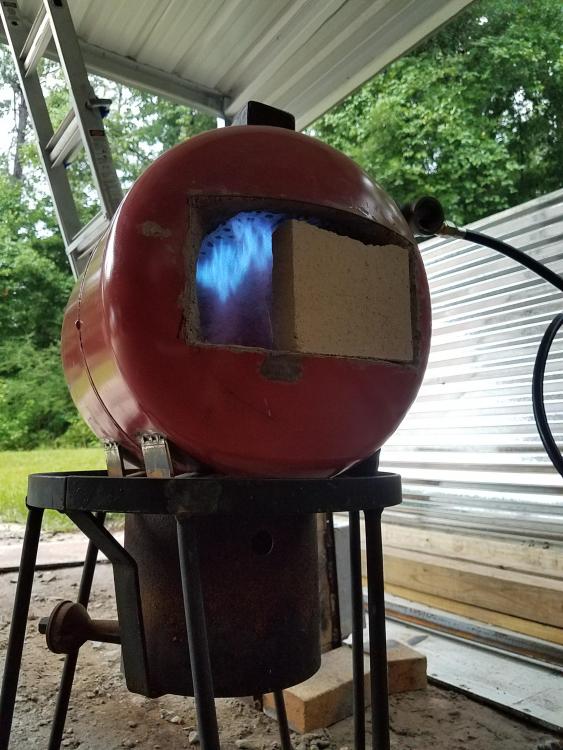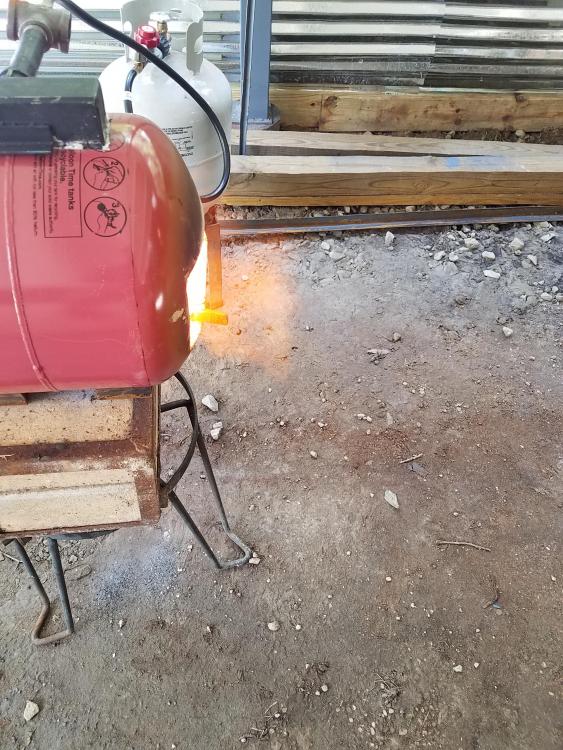-
Posts
37 -
Joined
-
Last visited
Content Type
Profiles
Forums
Articles
Gallery
Downloads
Events
Everything posted by the2ndcashboy
-

Naturally Aspirated Ribbon Burner. Photo heavy.
the2ndcashboy replied to Frosty's topic in Ribbon Burners
I made a new thread with my testing results. Does the Matrikote make the forge better? Sort of! -
So we had some discussion in the NARB thread about whether a kiln wash like Plistix or Matrikote would actually increase the max temp of a forge, or just make it heat stock quicker. I just built my first gas forge using a NARB, so it seemed like a good time to get some solid numbers, instead of subjective color heat reading. I'll start with the forge specs: I built it in a 20# propane sized bottle. Two 1" layers of wool, ridgidized and then coated with ~3/8" of refractory (Plibrico Hyrezist 2700, best I can tell its somewhere between Mizzou and Kastolite 27). I haven't made a slider for the brick doors yet, so for now I've been blocking about 3/5ths of the opening (4" high by 7" wide) with a fire brick. Burner is a 3/4" inducer NARB. I'd run the forge a couple times, and even semi-successfully forge welded, so I knew it was getting good and hot. I purchased a PID and type K thermocouple so I could get actual temperature readings throughout the test. Matrikote was painted onto the lining, ribbon burner flame face, and the flame side of the brick I used to partially block the opening. TC was inserted through the front, and extended about halfway to the back, directly under the burner (not ideal placement, but its a ribbon, most of the forge is directly under the burner). 1st test (no Matrikote): Cold (80*F) start @ 5psi 2 minutes @ 5psi and it was @ 1500F. Forge was just starting to glow. TC was probably mostly heated by direct flame. At that point, I turned it up to 10psi and let it run. 5 minutes @ 1750F 8 minutes @ 1900F (forge is a nice high orange/ low yellow 9 minutes @ 2000F 10 minutes @ 2040 The temperature basically plateaued at 9 minutes, and had pretty much stopped climbing completely by 10 minutes. I thought about cranking it up to max (20psi) but I didn't want to damage the TC before I had a chance to try the Matrikote. K-type TCs are rated up to 2300f, but I don't think it would live long in a flame at that temp. I waited til about 15 minutes and put in a block of cold-rolled steel measuring 2"x1.5"x1.5". Colors are somewhat subjective, but it was fully up to temp at around the 3:30 mark (bright yellow heat). 2nd test (after Matrikote): Cold (82*F) start @ 5psi 1 minute @ 1500F 2 minutes @ 1680F. Increased burner to 10psi and let it run. 3 minutes @ 1750F. Spots are starting to glow in forge lining, but majority of lining is not glowing even dull red. 5 minutes @ 1900F. Entire lining is starting to glow. Some spots are bright, others still dull. 8 minutes @ 2000F (temperature stopped climbing between 5-6 minutes, then slowly started climbing again) 9 minutes @ 2035F 10 minutes @ 2060F. At this point the temp was still slowly climbing, and the forge interior still wasn't glowing uniformly yellow, so I let it continue running. 14 minutes @ 2190F. Somewhere around the 13:30 mark it stopped climbing. Forge interior is almost uniformly glowing. I then put in the block of steel and timed how long it took to reach temp. It reached a uniform yellow around the 5:30 mark. Conclusions: The Matrikote seemed to reflect the flame heat very well. Temps came up much quicker, until about the 1800F mark, after which it slowed down considerably, to the point where at 10 minutes, the before/after temps were roughly equal. The forge lining heated up much slower with the matrikote. I ran it for about 20 minutes total, and the lining wasn't totally uniform until the last several minutes. Max temperature increased by 150F, but took an extra 4 minutes or so to reach. The real surprise was the stock heating test. I've always heard plistix/Matrikote will heat stock much quicker, but instead it took considerably longer. I actually took it out of the forge briefly around the 4:30 mark, because I was sure I just wasn't seeing the color properly. It was only yellow on the corners and edges, the center was still orange. It took another minute to heat fully. I'm really not sure what to make of that. In hindsight, it would have been useful to leave the TC in the forge while heating the stock. The lining may not have had as much stored heat due to the better insulation of the Matrikote, and therefore the forge temp dropped more after the stock was put in, so if I ran the same test after, say, 30 minutes, the stock might heat quicker (although I couldn't really see a "cold" spot around the stock, so I dunno). Alternatively, the Matrikote may be insulating both ways, and blocking some radiant heat from the lining. At a lower temp, the flame would heat the stock quicker than the forge lining would, so you might get a different result. I also suspect a forge without a refractory layer over the wool would gain much more from the application of Matrikote than mine did, since they have very little thermal mass to begin with. Overall, the Matrikote was probably a good addition, but I would have liked to see a better result on the stock heating test. I'm pretty happy about the increased max temp though. I should be able to forge weld at 10psi easily. Especially once I finish the brick doors on the front and get the burner properly mounted and insulated. Once again, I'd like to thank Frosty for the NARB development and plans. The thing runs great
-

Naturally Aspirated Ribbon Burner. Photo heavy.
the2ndcashboy replied to Frosty's topic in Ribbon Burners
I don't have the burner properly mounted yet, so there's a little hot gas leakage around it. Whenever I permanently mount it on the forge, I'll pack wool around it, that might help keep it a little cooler. Its possible that it's just something inherent to the design though. There should be a balance point where the cooling effect of the fuel/air mix can no longer counteract the heat soaking from the chamber. That balance point will change for each forge though, depending on insulation and size. Fir mine, it might be lower than 5psi, since I had it hotter and then turned it down after it was already heat soaked. If I started out at 5 and stayed there it might be ok for quite a bit longer. Maybe after I finish this round of testing I'll do another. Do a cold startup at 2psi and see how long it takes to get to temp, what that temp is, and if/when it starts woofing. Then crank it to 5 and see what happens. It's really not critical though, since I'll probably end up doing most of my forging around 10psi anyway. It just might be nice to be able to burn it lower for heat treating purposes. -

Naturally Aspirated Ribbon Burner. Photo heavy.
the2ndcashboy replied to Frosty's topic in Ribbon Burners
Round one of testing is complete. I ran the forge at 5psi for 2 minutes and was at 1500f (I think it was mostly just direct flame heating, the forge wasnt really hot yet). I then cranked it up to 10psi and hit 1750f at 5 minutes, 1900f at 8 minutes, 2000 at 9 minutes, and 2040 at 10 minutes. I stopped making notes at that point because it basically plateaued between 9 and 10 minutes. I didn't go up higher than 10psi because I didn't want to burn the thermocouple before I got a chance to test the Matrikote. 2040f is dang near welding temp anyway, I'm stoked that it does that at only 10psi. I also put in a 2"x1.5"x1.5" block of cold rolled to see how long it would take to come up to temp. It's a little subjective, but I'd say it was up to a nice yellow heat by 3:30. I would also note that after 20 minutes at 10psi, I turned it down to 5psi and did a little forging. It started "woofing" after about 10 minutes at 5psi. Turned it back up to 10psi and it was fine. I'm going to paint the flame face of the burner with the matrikote and see if it makes any difference there as well. I'll paint the forge interior with Matrikote tomorrow morning and then hopefully do the "after" testing on Saturday sometime. Maybe I should make a new thread with the complete results? I don't want to clutter up this thread too badly. -

Naturally Aspirated Ribbon Burner. Photo heavy.
the2ndcashboy replied to Frosty's topic in Ribbon Burners
Yeah, I know that wasn't the proper way to do it, but I wasn't trying to actually make anything. I just sanded the mill scale off both pieces and tossed it into the fire to see what would happen. More of a temperature test than anything else. I figured if the pieces of mild would stick together then I can weld anything (once I have the skill to do so). -

Naturally Aspirated Ribbon Burner. Photo heavy.
the2ndcashboy replied to Frosty's topic in Ribbon Burners
So the thermocouple and Matrikote are on order. Meanwhile, I've been playing around with the forge. I've never tried to forge weld, so I decided to try a fluxless weld with some mild 1/2" square stock (may as well aim high, right?). I can state with confidence that my forge does indeed get to welding temps. It wasn't a perfect weld, but it *did* weld in the center of the bar. I quenched it in water and tried to separate the pieces with a big chisel and they wouldn't move, so then I cut it across the weld and there's a cold shut about 1/3rd of the way across but the rest is welded solid. Shouldn't have any problem at all welding higher carbon steel with flux. -

Naturally Aspirated Ribbon Burner. Photo heavy.
the2ndcashboy replied to Frosty's topic in Ribbon Burners
Ok, y'all have me curious now. I'm going to rig up a thermocouple of some sort and do a before/after temp check with either plistix or matrikote. Might even try to find a pid with datalogging, that would be really informative to see the whole warmup curve instead of just the end result. I'll report back in a few weeks with my findings (honey-do list permitting). -

Naturally Aspirated Ribbon Burner. Photo heavy.
the2ndcashboy replied to Frosty's topic in Ribbon Burners
Yeah there's basically no dragons breath until the forge is up to operating temp, so it makes sense that it's the refractory burning off. Guess I'll run it for awhile as is then. I'll revisit burner tuning if adding doors doesn't get my temps up to welding heat. Or maybe just paint on some Plistix or Matrikote. I've heard that stuff works wonders. -

Naturally Aspirated Ribbon Burner. Photo heavy.
the2ndcashboy replied to Frosty's topic in Ribbon Burners
I cast it with crayons, so my holes should be the same as the original NARB, but I also cast it a full 2" thick, and after reading back through Frostys write up, I think his was only 1.5" thick (he said he used 2x2s for the form). You'd think the extra hole length would slow the gas jet down though, not speed it up. Maybe its cause I'm near sea level, and Frosty is at a higher elevation? At any rate, the thing works fantastic, I'm just fine tuning at this point. I think if it was a smaller forge then the air velocity might start to be a problem, but mine is on the upper end of what this burner will do, so it's not really a problem. Pics of the flames. Cold startup. 1st pic is 2psi, 2nd is 10, 3rd is 20. Ignore the orange streamer in the 1st pic. Just a bit of crayon wrapper burning off. -

Naturally Aspirated Ribbon Burner. Photo heavy.
the2ndcashboy replied to Frosty's topic in Ribbon Burners
I'll have to try grinding a bar shiny and see how it scales. I was mainly going by the amount of scale it was leaving on the anvil. I had heard the same thing about the NARB running on the rich side, so I was surprised when mine seemed lean. Mine almost acts like it could use one more hole (I used the 19 Frosty settled on). Like maybe the air velocity is borderline too high. It won't really burn at all outside of the forge, and when the forge is cold, there's a fair amount of flame standoff at 3psi and above, but it'll still stay lit from 1-20psi. As the forge heats up the standoff goes away, and then you can't see the individual flames at all when it's all the way up to temp. Never any popping or anything unless I go down to <1psi, then it will flutter and pop out. That's a more than acceptable bottom end though. -

Naturally Aspirated Ribbon Burner. Photo heavy.
the2ndcashboy replied to Frosty's topic in Ribbon Burners
I have extra .035 tips and the drill bits I'd need to enlarge them, so I'd rather do that than buy more tips. I guess my question was more "is my burner actually running 'lean' or am I reading the signs wrong?". -

Naturally Aspirated Ribbon Burner. Photo heavy.
the2ndcashboy replied to Frosty's topic in Ribbon Burners
So I just want to say "thanks" to Frosty. I made my very own NARB this weekend and it's pretty sweet. Runs great from 1psi all the way up to 20psi (my regulator's max pressure). I put it in a propane bottle sized forge with 2" of wool and ~1/2" of refractory cement (hyrezist 2700 from plibrico if that matters). Internal volume is just under 300ci. It gets to a bright yellow heat at 20psi with the opening halfway blocked (opening is 4"x7"). I dunno if that's quite welding temp or not, since I'm a total noob, but I'd say it's pretty close if it isnt. The mild steel stock I was playing with wasn't sparking. I'm thinking the burner is running a little "lean". I'm running a full-length Tweco .035 welding tip for the jet, and I'm not getting anything but medium orange dragons breath even at 20psi. At 10psi there barely any dragons breath at all. There also seems to be quite a bit of forge scale on the bar I was heating. Should I ream the tip out a bit and try that? I'm not planning on forge welding right away, but I think I'd like to try it in the future.

